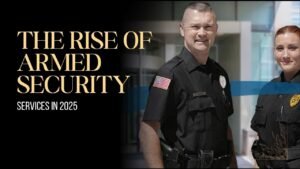When global leaders, celebrities, or business magnates attend high-profile events, security becomes the backbone of the occasion. From red carpet premieres and award ceremonies to diplomatic summits and corporate galas, these gatherings attract both attention and risk.
VIP events are more than celebrations—they are symbolic showcases of influence and power. But with prominence comes exposure. Public appearances make notable figures targets for threats ranging from physical harm to digital sabotage.
In this environment, security teams serve as the silent guardians, ensuring that nothing disrupts the event’s flow. Their mission is not just to react to danger but to anticipate and prevent it before it happens.
This detailed guide explores exactly how these professionals protect VIP events—covering every stage from planning and intelligence gathering to on-site management, crowd control, and emergency response.
The Importance of VIP Event Security
VIP events combine prestige, publicity, and unpredictability. Without robust security, even a single misstep can cause chaos. A gatecrasher, protest, or data leak can damage reputations and endanger lives.
Security is not just about protecting a person—it’s about safeguarding image, continuity, and confidence. Event organizers and clients rely on security professionals to ensure seamless operations that keep both guests and hosts safe.
Why VIP Security Is Critical
- Public Visibility: The higher the status, the higher the risk.
- Unpredictable Threats: Physical attacks, protests, or cyber intrusions.
- Crowd Behavior: Excited fans or press can unintentionally create hazards.
- Information Leaks: Sensitive details like VIP schedules can be exploited.
Phase 1 — The Foundation of Security: Risk Assessment
Every successful security operation begins with a thorough risk assessment. Before the first guest arrives, experts conduct deep analysis to identify potential vulnerabilities.
This involves studying the venue, audience demographics, and recent security incidents in the region. Teams also evaluate the profile of VIPs attending—understanding who they are, their public reputation, and any past threats or controversies.
Key Elements of Risk Assessment
| Factor | Description | Example of Risk |
|---|---|---|
| Venue Layout | Size, exits, surrounding roads | Narrow exits increase congestion |
| Public Access Points | Entrances or parking lots | Easy infiltration without ID checks |
| Political or Social Climate | Local protests or tensions | Demonstrations disrupting entry |
| VIP Profile | History of threats or controversies | Political figures face targeted hostility |
| Digital Vulnerabilities | Unsecured Wi-Fi or devices | Cyber intrusions or leaks of data |
A comprehensive risk assessment creates the blueprint for security strategy—from perimeter control to internal staff clearances.
Phase 2 — Strategic Planning and Coordination
Once the risks are identified, it’s time to turn data into a strategy. Security planning involves detailed coordination between multiple entities—private security firms, event management staff, local police, and medical responders.
The main goal is to establish a layered defense that protects all aspects of the event—physical, digital, and reputational.
Pre-Event Planning Checklist
- Venue Survey and Mapping: Analyze every corner, from backstage routes to parking exits.
- Credentialing System: Verify staff, vendors, and media through background checks.
- Access Control: Issue color-coded badges for different clearance levels.
- Perimeter Security: Install barricades, fencing, and surveillance coverage.
- Emergency Response Plan: Prepare evacuation procedures and first aid points.
- Technical Security: Secure communication networks and control rooms.
Security planning isn’t just paperwork—it’s a living system that evolves with updated intelligence until the day of the event.
Phase 3 — Personnel Deployment and Zone Management
Once the strategy is finalized, on-site security teams are deployed based on zone assignments. Each team member knows their sector, communication protocol, and emergency role.
Example of Zone-Based Deployment
| Zone | Responsibility | Assigned Team |
|---|---|---|
| Entrance & Exit Gates | Metal detection, ID verification | Access control officers |
| VIP Holding Area | Personal protection, access screening | Bodyguards & handlers |
| Main Event Floor | Crowd management & surveillance | Floor supervisors |
| Stage or Podium | Close protection for speakers | Tactical bodyguards |
| Parking & Drop-off | Monitoring suspicious vehicles | Patrol units |
| Command Center | Communication & coordination | Security director & analysts |
This zoning ensures no overlap or blind spot in coverage. Every area has dedicated personnel monitoring it continuously.
Phase 4 — The Human Element: Trained Security Professionals
Even the best technology is ineffective without the right people behind it. VIP event security relies on trained and disciplined professionals who combine alertness with discretion.
Core Roles in a VIP Event Security Team
| Role | Main Duty | Skillset Required |
|---|---|---|
| Security Director | Overall leadership and coordination | Strategic planning, leadership |
| Personal Bodyguards | Direct protection of VIPs | Defensive tactics, communication |
| Surveillance Operators | Monitor camera feeds | Observation, analysis |
| Event Security Officers | Manage access points | Interpersonal skills, vigilance |
| Crowd Managers | Control public movement | De-escalation, crowd psychology |
| EMT & First Aid Team | Handle medical emergencies | Medical training, quick decision-making |
Every team member goes through briefings, scenario rehearsals, and communication tests before deployment. Their goal is simple: anticipate, deter, and respond without disrupting the event experience.
Phase 5 — Crowd Control and Behavior Monitoring
Crowd management is one of the biggest challenges in any VIP event. Even well-intentioned attendees can create dangerous situations if they surge toward a celebrity or rush for entry.
Security teams use both psychological and physical tools to maintain calm and order.
Effective Crowd Control Techniques
- Zoning and Barriers: Dividing spaces into public, restricted, and backstage areas.
- Queue Management: Guiding flow using ropes, signage, and staff instructions.
- Behavioral Observation: Identifying suspicious or agitated individuals early.
- Communication Systems: Using loudspeakers or SMS alerts for crowd directions.
- Controlled Entry: Using ticket scanners and ID verification to prevent overflow.
Professionals are trained to read micro-behaviors—nervous gestures, abrupt movements, or scanning eyes—often spotting potential trouble before it happens.
Phase 6 — Technological Integration in VIP Security
Modern VIP event protection is a blend of human expertise and cutting-edge technology. From surveillance to biometric systems, technology enables faster decision-making and higher accuracy.
Modern Tools Used by Security Teams
| Technology | Function | Benefit |
|---|---|---|
| CCTV & AI Cameras | Monitor and analyze crowd activity | Real-time detection of anomalies |
| Facial Recognition | Identify flagged or blacklisted individuals | Prevent unauthorized access |
| Metal & Explosive Detectors | Screen guests and packages | Physical threat prevention |
| RFID Wristbands | Authenticate guests and staff | Easy movement tracking |
| Drone Surveillance | Aerial monitoring of open venues | Detect large-scale disturbances |
| GPS Tracking | Monitor movement of VIP convoys | Ensures travel safety |
| Encrypted Radios | Secure communication channels | Prevent eavesdropping or leaks |
Technology enhances coordination, but human judgment remains irreplaceable. Machines can detect, but humans interpret—and that distinction saves lives.
Phase 7 — VIP Escort and Close Protection
Close protection is the most visible form of VIP security. Bodyguards are trained not only in defense but in anticipatory movement, ensuring clients are always one step ahead of danger.
Core Duties of Close Protection Officers
- Conduct pre-route inspections before VIP movement.
- Maintain visual coverage while blending with surroundings.
- Coordinate with drivers, advance teams, and entry staff.
- Manage press and fan interactions with controlled distance.
- React instantly to signs of threat, shielding the client and moving to safety.
These professionals balance approachability and authority, ensuring the VIP feels protected yet free to engage confidently.
Phase 8 — Emergency Preparedness and Crisis Management
No matter how well an event is organized, unforeseen crises can arise. Whether it’s a fire alarm, a protester breach, or a medical emergency, the ability to act fast and in coordination defines a team’s success.
Typical Emergency Response Framework
- Detection: Rapidly identify the issue through surveillance or reports.
- Containment: Secure the affected zone and stop spread of panic.
- Communication: Alert command center and on-site personnel.
- Evacuation: Move guests or VIPs to safe areas using pre-defined routes.
- Neutralization: Engage law enforcement if criminal intent is confirmed.
- Recovery: Provide medical support and restore normalcy quickly.
Teams conduct drills for fire, bomb threat, and medical scenarios weeks before the event to ensure muscle memory-level response when seconds matter.
Phase 9 — Cybersecurity and Data Protection
In the digital age, VIP events are not only vulnerable on the ground but also online. Hackers can target event networks, digital passes, or even live-stream systems to cause chaos or steal sensitive information.
Key Cybersecurity Measures
- Encrypted Communication: Protects radio and digital channels from interception.
- Secure Wi-Fi Networks: Prevents unauthorized access to event systems.
- Two-Factor Authentication: Adds extra protection for admin access.
- Surveillance Data Encryption: Ensures footage cannot be tampered with.
- Cyber Response Unit: A small team ready to isolate and patch network issues.
Today, the line between physical and digital security is blurred—protecting a VIP’s data is just as important as guarding their person.
Phase 10 — Post-Event Review and Debrief
When the event ends, the mission doesn’t. The post-event phase focuses on evaluation, recovery, and learning.
Key Steps in Post-Event Analysis
- Incident Reporting: Every anomaly is documented for record and improvement.
- Surveillance Data Review: Footage is analyzed to identify potential oversights.
- Debrief Meetings: Teams discuss what went well and what can improve.
- Equipment Check: Devices are cleaned, tested, and stored for future use.
- Client Feedback: Gathering input from organizers or VIPs to improve satisfaction.
Post-event reviews close the loop, ensuring that each operation refines the next one. The most elite security firms treat every mission as both a protection detail and a learning opportunity.
Complete Framework of VIP Event Security
| Security Phase | Objective | Tools Used | Personnel Involved |
|---|---|---|---|
| Risk Assessment | Identify and evaluate threats | Surveys, data reports | Analysts |
| Planning | Develop strategies and protocols | SOPs, maps | Security directors |
| Zone Deployment | Ensure coverage and communication | Radios, GPS | Guards, supervisors |
| Crowd Control | Manage public safely | Barriers, scanners | Crowd managers |
| Tech Integration | Enhance detection and response | CCTV, drones | Surveillance team |
| VIP Escort | Protect high-profile individuals | Convoy routes, shields | Bodyguards |
| Emergency Response | Handle crises effectively | Radios, first aid kits | Rapid response unit |
| Cybersecurity | Secure digital environment | Encryption, firewalls | IT security team |
| Post-Event Review | Improve future readiness | Reports, analysis | Supervisors, analysts |
The Human Factor — Coordination and Discipline
Beyond protocols and tools, what makes a security operation successful is human synergy. Every individual—from the director to the last checkpoint guard—works under unified discipline.
Clear communication channels prevent confusion. Pre-defined command hierarchies eliminate hesitation during emergencies. This structured teamwork ensures that even in high-stress conditions, decisions are made calmly and executed instantly.
A single second of indecision can lead to disaster; therefore, coordination is not just a method—it’s the culture of professional security.
Lessons from High-Profile Events
Global events have taught security agencies valuable lessons over the years:
- 2012 Olympics (London): Highlighted the need for integrated private and military security partnerships.
- Film Festivals and Awards: Showed importance of crowd psychology management.
- Political Summits: Reinforced the role of pre-screened zones and communication encryption.
These real-world examples shaped today’s best practices, where preparation is constant and prevention is invisible.
Protecting VIP events demands a blend of science, strategy, and intuition. Security teams must think like attackers to stay one step ahead, coordinate like soldiers under command, and act like diplomats under pressure.
From the earliest risk assessment to the final guest’s departure, every moment is carefully engineered to maintain control and safety. These teams protect not just individuals, but the integrity of the event itself.
In the end, the true mark of success for a security operation is when no one notices it at all—because flawless safety looks like normalcy.
FAQs
What is the main goal of VIP event security?
The primary goal is to ensure the physical safety, privacy, and seamless experience of high-profile guests while maintaining order and preventing disruptions.
How do security teams prepare for emergencies during events?
They conduct advance drills, establish evacuation plans, set up medical response stations, and maintain real-time communication systems for instant coordination.
Are private security firms as effective as government protection agencies?
Yes. Many private firms employ ex-law enforcement or military professionals with advanced training, offering specialized services tailored to the event’s scale and risk profile.




